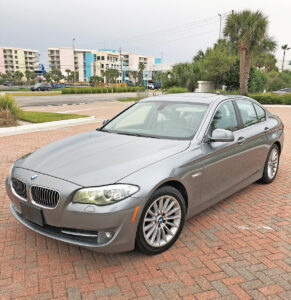How to Land The Right Preowned Car at the Right Price
Whether you’re shopping for your first car, truck or SUV or in the market for your 15th one, vehicle shopping can be a tedious chore, and that’s especially true in today’s automobile market.
There’s often such a fine line between a really great deal and a really bad one, but the more you educate yourself ahead of time, the better the probability of you getting the car you need at a price that’s right, along with dependable service and financing terms that you’ll be happy about well after the new of your new (to you) ride wears off.
 Preowned vs. New: There are often many incentives to buying preowned instead of new. The most obvious? “The right” used vehicle can usually save you money upfront, as well as save on insurance, registration and taxes. Perhaps the greatest reason buying preowned often makes sense, though, is that you get more car for less money. And if you buy right and get into a three-to-five year old model, a large chunk (usually around 45% to 60%) of the new car price depreciation was already absorbed by the previous owner.
Preowned vs. New: There are often many incentives to buying preowned instead of new. The most obvious? “The right” used vehicle can usually save you money upfront, as well as save on insurance, registration and taxes. Perhaps the greatest reason buying preowned often makes sense, though, is that you get more car for less money. And if you buy right and get into a three-to-five year old model, a large chunk (usually around 45% to 60%) of the new car price depreciation was already absorbed by the previous owner.
I understand that there will always be advocates for buying new, because, in theory at least, it’s less hassle since a new car should have zero issues and very little maintenance needed for its first few years of ownership. However, that doesn’t hold true near as much as it might have 20 years ago. Nowadays, most any modern car or truck (other than some high-end exotics) should easily be very dependable for well past 100,000 miles, with routine oil changes, tires and brakes. By contrast many brand-new cars will need the same things during your first three years of ownership, yet still burden you with a higher payment while also taking on those maintenance costs.
Here, I’ve compiled an overview on how to shop smart and get the right deal on the car, truck or SUV you really want when going the preowned route. Many of these steps can help assure your best deal when buying new, too.
Know Your Needs: Determine what vehicle you really want, and need, and look for that vehicle as opposed to simply blindly searching for whatever seems to be available. Remember, just because something is a good price, or in good condition, doesn’t mean it’s a good deal for you. Think about how you plan to use the vehicle and what options you can do without and which ones you consider a must have. Make sure you have narrowed down a handful of vehicles that meet your need based on size, cargo capacity, EPA fuel mileage, reliability, cost of ownership, and a price range you can “really” afford without being car rich and cash poor.
You can, and should, research any vehicle you are considering, in detail, before buying the car. Don’t rely on the salesperson at the dealership to do this. They can still help you find and close the best vehicle for you, but you need to do your own homework first.
It’s important to know that even very reliable brands often have certain vehicles in particular year ranges and drivetrain configurations that are problematic. For instance, I often buy Mercedes, BMW, Porsche and other Euro makes. However, there are certain cars from these brands I would not even consider because of particular problems that plagued certain models and years. This holds true with any make from a Ford F150 truck to a Jeep or Porsche, and even to Hondas, Hyundais and Toyotas, though, across the board, most of the Asian brands have proven to be the least problematic to maintain cost effectively, and in many cases the most reliable for the money. And, I’m saying this as someone who drives mostly European cars myself. The truth is, most all of us who consider ourselves real car fanatics understand that the more a brand costs, and the fewer of them there are on the road, the more the cost of ownership is going to be. It doesn’t mean highline brands aren’t cutting-edge engineering marvels and the most fun to drive, just that they also cost the most to drive.
Set a Budget: There are really only two ways to buy a vehicle: You either pay cash or you have a payment. Either way, try to refrain from buying more than what makes good financial sense. It always puzzles me when I hear people complain about barely being able to make their payments, or not having money to do other things, because they are driving around in vehicles that are $500 to $1,000 a month. Most financial consultants agree that whether you are paying cash or financing (no matter how great of price you might have gotten at the time of purchase) the purchase price of your vehicle should be no more than 35% of your annual gross income. This means buying a $50,000 vehicle if you’re making $100,000 a year doesn’t make good financial sense. We all know A LOT of people who’ve fallen into the “keep up with the Joneses” trap of spending a high percentage of their take-home income on a single car payment. Even lenders consider anything more than 20% of your take-home earnings per month to be an excessive car payment. This doesn’t mean you can’t be smart and still drive a car you like. In fact, you can often buy that same (or one body style back) vehicle that is three to five years old and have a payment that’s around half of what other buyers who bought the same vehicle brand new are still paying for theirs.
Once you have a handful of particular cars in mind, use sites like NADA (National Auto Dealers Association) and Kelly Blue Book to research the current book value of the specific make, model and year you are looking for or have seen listed for sale. Remember to pay attention to the “retail value” and “private party value” when comparing prices. Know these values and let any dealership or individual seller know you have researched and know the value of what they are selling, if their price is for any reason higher than what the book value shows it should be.
There are big benefits to buying from a reputable dealer, and though you may sometimes pay slightly more than you would if you were buying the same vehicle from an individual, sometimes you will pay even less, and could get a car or truck that has recently been inspected and had routine maintenance and needed repairs already done. Ask about this, and what has been done, along with any warranty they offer.
Get Pre-Approved: If you are financing, buying from a dealer is usually simpler than from a private seller. This is especially true if you have a trade-in. Though anyone with good credit can often borrow the money from their credit union, bank or various online auto lenders and get the same rate they would receive going through the dealer. Either way you go, it’s a good move to get preapproved for an auto loan, because it simplifies the buying process and puts you in a stronger negotiating position at the dealership, since they will already know you can buy today, if they simply work the right deal for you.
Go for a Test Drive: Once you’ve located a vehicle you’re interested in, go for a test drive. If the vehicle is at a dealership, this is pretty standard. However, if you’re considering buying from a private seller, take precautions to meet at a safe place and preferably take someone else with you to meet the seller. Remember to ask questions about the vehicle’s maintenance and condition, as well as their ownership experience and even why they are selling it.
Whether test driving a dealership’s or individual seller’s vehicle, make sure to get in a few miles of driving at highway speeds, as well as some turns, stops, hills and curves. It’s best to do this with the entertainment system off (I know, I know… you want to know how good the stereo sounds) and with a keen ear and feel for any noises or unusual handling characteristics of the particular car or truck. Do all of the gauges function and measure where they should? Do the brakes squeak? How does the steering feel? Does the transmission shift out, up and down, smoothly? Do all of the windows and lights work properly? Does the sunroof, navigation and sunroof function as they should? Do all the signals work? How does the car feel starting and stopping? If anything seems out of place, ask about it.
Check the Vehicle History Report: Before you buy any preowned vehicle, ask the dealer to see a vehicle history report. If you’re buying from an individual, it’s usually worth the small fee to run it yourself if they don’t have a recent one handy. Through companies like Carfax, AutoCheck, KBB and others, you can get a somewhat detailed history report using the vehicle’s identification number. I say “somewhat detailed,” because not all of the events such as services and repairs are always on the report, as some service centers and dealers report to Carfax and AutoCheck (or others) and some don’t. So, don’t be alarmed if you see random oil changes and services. What you are really looking for here are irregular title issues, major body repairs, number of owners, along with mileage discrepancies. I wouldn’t be too concerned with small repairs like bumper covers or a headlight or taillight replacement, but you should note, from the report, where the damage was and whether listed as minor or severe. The truth is a lot of cars have some small blemishes on these reports from minor occurrences that don’t otherwise impair the vehicle once properly repaired. I’d even go so far as to say that there are some rebuilt salvage title vehicles that are great dependable cars, after being repaired correctly and inspected by the title issuing state and given a clean bill of acknowledgement. Still, these cars –no matter how great of condition—are normally worth 25% to 40% less than the same exact vehicle, with the same mileage, and a clean title.
Talk Price: This is the part that so many people dread. However, it’s also the part that can make a lot of difference in whether you go home with a good deal or a bad one. Though a lot of modern dealerships do operate on a no negotiation basis where the price is set in relation to what the true retail book value is, this isn’t always the case with every dealer, and certainly isn’t with private sellers. This is why you did your homework, and you know the value of the vehicle yourself.
Let’s say the seller is asking $18,900 and your detailed research shows the vehicle is worth $16,400. Use your negotiation skills to point that out. Let’s face it, unless you’re walking, and can’t find another car for sale within a 50-mile radius, it wouldn’t make sense to overpay for the car, no matter how much you like it. Remember, this isn’t a house. This is a constantly depreciating asset. If you overpay for it today, you will over owe for it for a long time. Use this as a time to bring up any small imperfections in the vehicle or anything you noticed in the inspection or test drive. After doing that, simply make an offer such as: I really like the car, but I am not willing to pay over what the value is for the car. I will offer you $16,000, but I can’t go any more than that. Now, be willing to buy or walk. Maybe they come back at the $16,400 it’s worth. If so make the deal. Remember: If you are buying from a dealership, they also have set dealer fees. These often range from $400 to $900, and are called a variety of different names such as “doc fees” or “documentation fees,” but the closest one to truth is “dealer profit.” It’s completely fine and part of the process to pay these, and most dealers have learned not to budge on these fees, as their margins have gone down over the past decade, and they actually need them to survive in many cases. Just know that when figuring a final out-the-door price, that fee, and your state registration fees and taxes are going to be added to your final price. Whereas, when buying from a private party you’ll have to pay registration, title transfer and tag fees at your local DMV office when you go to tag the vehicle.
Remember, when you are negotiating at a dealership you are doing it with professionals who do this for a living, and they are getting paid based on what you pay for the car. Again, that’s absolutely fine and that is their job. However, don’t let yourself fall victim to becoming a monthly payment buyer who pays too much for a vehicle, as long as they can get the payment where you want it. Sure, the payment matters, and the interest rate, added fees and other terms certainly do. The bottom line is, if you pay over the retail book value, you paid too much no matter how affordable you feel your payments are.
When closing the deal, you’ll also be asked about additional purchases such as gap insurance and extended warranties. These are not bad purchases to consider–especially if you are financing the car. Before you agree to any extended warranty, however, know about any existing manufacturer’s warranty or dealer warranty that the car may still be under, and decide accordingly, based on the vehicle’s age, mileage and condition, whether you are likely to justify the cost of an extended warranty (often $1,400 to $2,000 or more) versus potentially having to pay for potential repairs yourself. Personally, I’ve only purchased an extended warranty once in over 30 years of owning various cars. Even then, it wouldn’t pay the simple $400 part that went out on my Jeep at the time. So, I forgo those, but do put a lot of merit into cars with existing CPO manufacturer’s warranties, though they don’t cover routine maintenance items.
If you’ve made it this far, done your due diligence, and followed all the steps herein, you’re likely to be able to head home in a preowned vehicle you really like, and one you can feel good about not only the day you buy it, but also three months or a year later when the new has worn off a little and it’s settled into being another one of your “things,” just like those favorite worn jeans, old Chuck Taylors, or that TAG watch you spent two week’s pay for 10 years ago.
Will Estell is a writer and magazine editor, with over 400 published articles in various publications, as well as numerous online articles in an array of genres. He’s been instrumental in founding 11 magazine titles from concept to fruition, for other publishing companies and his own partnerships. Will actively partakes in freelance media projects for select local, regional and national publications such as this one. Will is a father of three who splits his time between homes in Destin and Navarre, along with his wife, ABC news anchor, Laura Hussey. When he’s not writing, creating or consulting, he enjoys playing with cars…real ones.































































